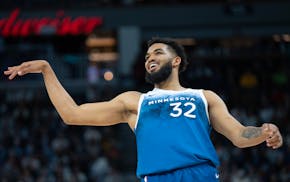Joey Browner was selected 19th in the first round of the 1983 NFL draft. He turned out to be the best do-it-all safety in Vikings history. He had range and tackled with authority during nine seasons in Minnesota.
Harrison Smith was selected 29th in the first round of the 2012 draft. He energized the Vikings' play at safety in his rookie season. He showed range and tackled with authority.
Browner's unique gift was hands of such strength that he could reach out with one, grab a ball carrier by the back of his jersey or shoulder pads and yank him to the turf.
Smith made a play similar to that last fall in bringing down Washington quarterback Robert Griffin III. The result was a $15,750 fine from the NFL for a "horse-collar" tackle.
Times have changed mightily, when it comes to the freedom for a safety to make plays and deliver hits, since Browner's career was winding down in the early '90s.
"Even in the past few years, since I started playing safety at Notre Dame, there's a big difference," Smith said. "Where you can hit a guy, how you can hit him … that's changed a lot."
The "horse-collar" tackle was made illegal by the NFL in May of 2005. It seems to be the easier of the fine-inducing plays for a hard-charging safety to eliminate.
Smith also was fined $21,000 for a hit on San Diego receiver Mike Willie in an exhibition game last season.
"They said that one was helmet-to-helmet," Smith said. "In my opinion, he lowered his head as I was making the tackle. The league said the fine was because my feet were off the ground. I was jumping over to make the play …"
Smith paused in a conversation Wednesday and said: "I don't want to spend time complaining … there's nothing to be accomplished. It's not easy, you're coming at full speed, and the guy with the ball is moving fast, but the league knows how it wants you to hit people.
"As a rookie, at first you're saying, 'I'm going to play football the way I've always played, and the officials will make their decision,' but eventually you have to adjust. It's simple: When you get a penalty, it hurts the team."
Again this year, the NFL sent officials to training camps and most of the discussion with defensive players was where the league insists on contact being made.
"They want us to lower the target area … no higher than here," said Smith, putting his hand just below the breast bone.
Back to Point A in this discussion: How can the NFL authorities expect a safety, storming forward from the back of a defense, to hit a bull's-eye on a runner or receiver who is darting, dodging or zooming to avoid him?
"That's what you have to do, or it's probably going to be 15 yards," Smith said.
The other emphasis in tackling technique is to not lead with the helmet.
"That's been around since I started playing football: Tackle with your head up," Smith said. "This safe tackling program the NFL is pushing for youth football … I don't see than as anything new."
On Sunday, the Vikings defense had a lousy day, although Smith did recover a Detroit fumble and had a couple of memorable thumps among his 10 tackles. Neither came with controversy; his biggest hits were legal by the NFL's ever more stringent tackling rules.
Tackling fines weren't the league's only attempts to extract money from Smith in 2012.
"I had a third fine for an equipment violation," he said. "The league lowered that one on appeal. That didn't happen when I appealed the other two, for the hits."
Smith did escape another potential attack on his paycheck last Oct. 7, when he was ejected in the second quarter of a game vs. Tennessee at the Metrodome.
This came as official Steve Freeman, in exuberant fashion, attempted to clear away players from a scrum and Smith gave him a shove — figuring it was a Titan, not a guy with a whistle.
There would no fine and the Vikings won 30-7, and that made it a rare knockout for a player over the autocrats in the NFL office.
Patrick Reusse can be heard 3-6 p.m. weekdays on AM-1500. preusse@startribune.com

Reusse: Taylor's story. 'I just bought the Minnesota Timberwolves.'

Reusse: Back from injury, Towns doesn't have to carry load


